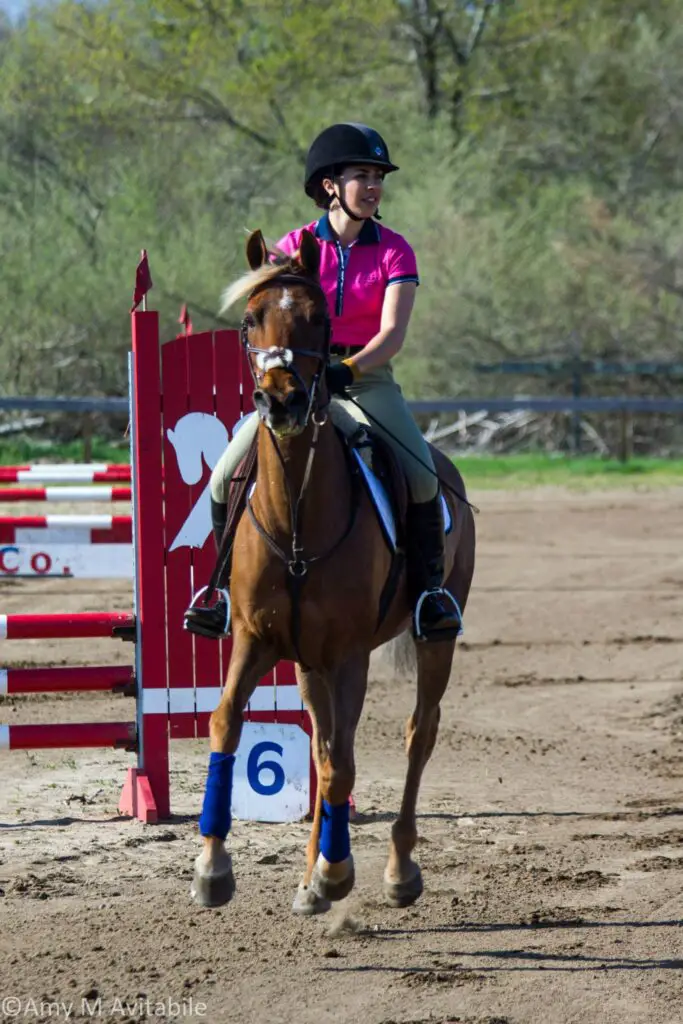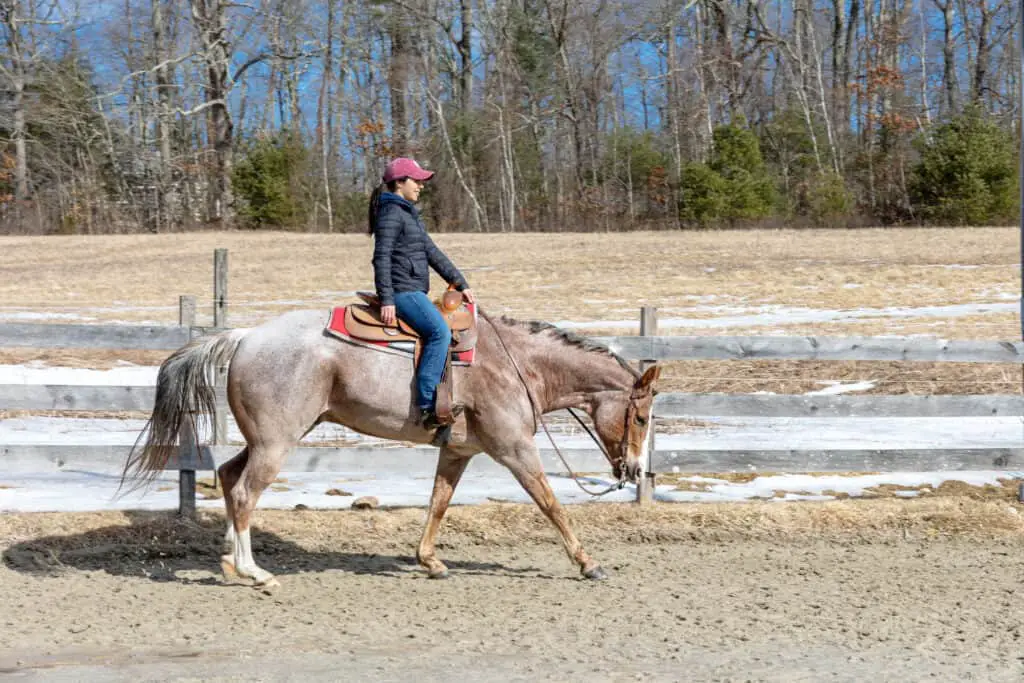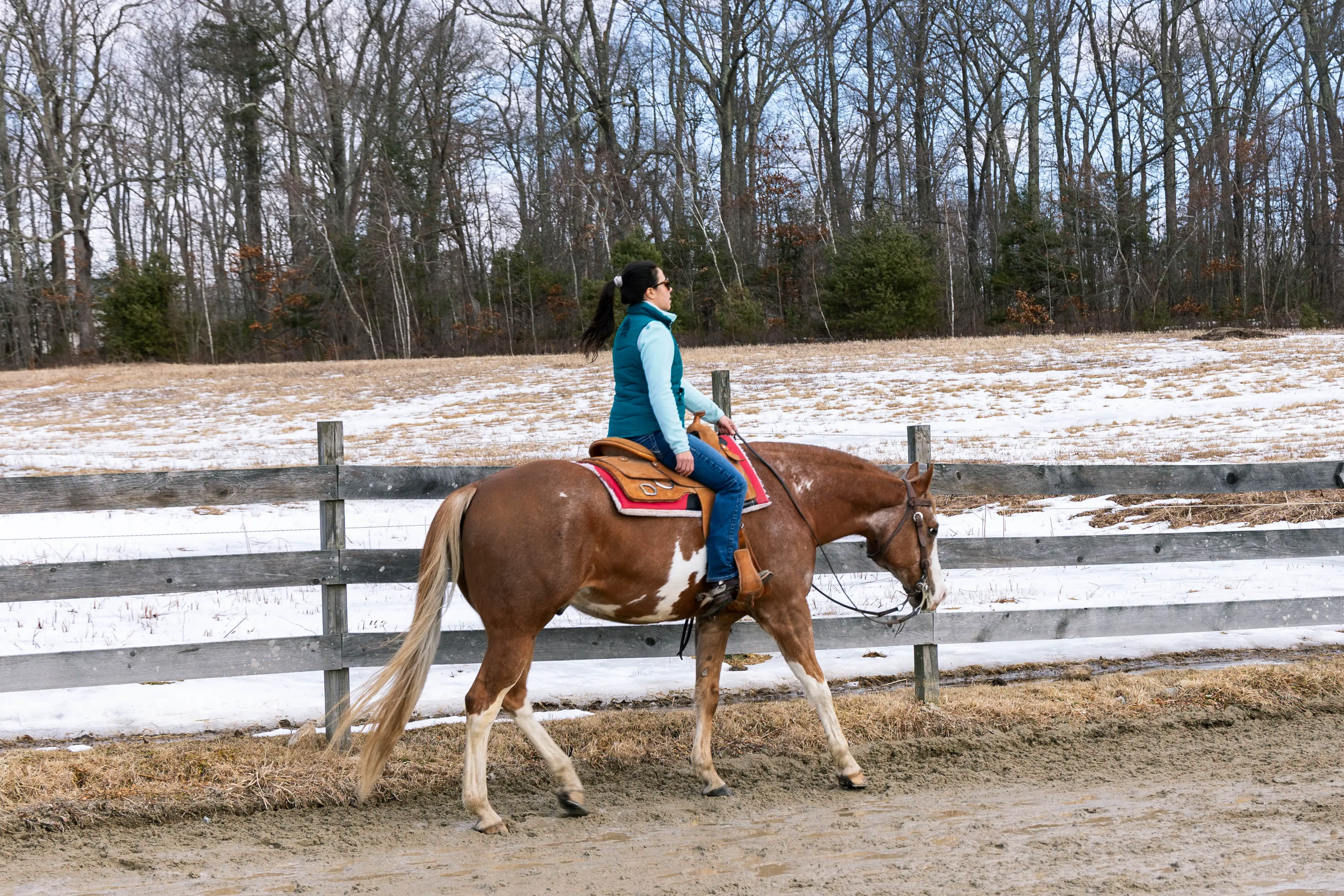In the United States and countries around the world there are many different styles of riding and many different riding events. Some of which we will cover in this article. Most of these styles of riding fall into a larger category or either English Riding or Western Riding. In this article we’ll review what English and Western Riding are and the main key differences including the tack, disciplines, attire and riding styles.
If you’re interested in starting riding lessons this guide will help you decide if you would prefer to ride English or Western. If you already ride, it may inspire you to try something new!
What Is English Riding
English riding is the style of horseback riding which originated in Europe. The English riding style uses a smaller saddle, direct rein contact and forward moving gaits. Most people envision horses jumping large fences at a full gallop when they picture English riding.

What Is Western Riding
Western riding for most people is synonymous with cowboys! The primary difference is that western riders and cowboys ride with one hand in order to keep their other hand free for herding cattle, roping etc. The western saddle is much larger and heavier than the western saddle and has a horn.
Steering With Direct Rein Vs. Neck Rein
The first and most noticeable difference between English riding disciplines and western riding disciplines is how the rider uses the reins. In English riding disciplines the rider keeps both hands on the reins and uses a direct rein to steer and cue the horse. This means, when the rider puts pressure on one rein the horse will turn in that direction. English riders also keep more contact with the bit although this not to say they never ride with slack in the reins. If hacking out on the trail or allowing the horse to stretch a longer rein may be used.
Alternatively, in western riding disciplines the rider typically keeps both reins in one hand. While riding with one hand the rider can have contact when needed and can lift the bit to use leverage to help the horse collect. The contact will then be released when the horse gives to pressure and thus typically you will see western horses ridden on a looser rein. This means that the rider does not pull the reins or one side of the bit to turn the horse as they would with a direct rein. Instead, light pressure from the rein is applied to the horse’s neck which directs the horse to turn away from the pressure.
It’s important to note that in western disciplines, young horses are often ridden in snaffle bits with two hands and the rider uses a direct rein. Western horses do understand and can be ridden with a direct rein similar to English horses and this is common practice for schooling, even in older more educated horses.
Seat and Leg Position
Compared to hunter and jumper riders, western riders tend to have longer stirrups and a deeper seat similar to dressage. Often, English hunter and jumper riders will have shorter stirrups and a lighter seat contact in order to help the horse move freely underneath them. This is also essential for jumping in order to allow the horse to round his back and lift his legs off the ground.
English riders also keep more leg contact with the horse due to a smaller and lighter saddle. Regardless of discipline and stirrup length it is important to ride with heels down and shoulder, hip and heel aligned for maximum balance, safety and effectiveness.
Rein Contact
In general, in English riding disciplines the horse is ridden with more contact than in western disciplines. Often times, western horses are ridden with a stronger bit but lighter rein contact and softer cues. While the rein contact and type of bits used for each discipline vary riders across disciplines are looking to achieve common goals. Even if their cues differ, riders use rein contact along with other aids like leg and seat to create a balance and control and improve athleticism.
Gaits In English And Western Riding Disciplines
While both English and western disciplines share many similarities there are a few key differences to note.
Horses in both disciplines travel at a walk which is a four beat, relaxed gait. The speed may be a touch slower and relaxed in the western disciplines while it is more ground covering in English disciplines.
English horses trot while western horses jog. A trot is a forward two beat gait in which the rider typically posts which means rising up and down in rhythm with the horse. English riders do also sit to the trot especially in dressage, however it is still much more forward than a western jog. For more information on posting trot and learning to post, check out this article.
Western horses jog which is also a two beat gait but is much slower and the riders can sit comfortably for long periods of time. Western riders do sometimes ask their horse to trot and they also know how to post. However, the jog vs trot is one of the key differences between English and Western riding.
Lastly, English horses canter while Western horses lope. A canter and a lope are both three beat gaits in which the rider can sit. Similar to the trot, a canter is typically more forward and ground covering than a lope. A lope is usually slower and more relaxed. Western horses do sometimes lope fast like in reining patterns.
A common misconception is that western horses are always slow compared to English horses. This is not always the case, there are many western speed events which require horses to trot, canter and gallop. Western pleasure riding involves slower gaits which are more relaxed and comfortable.

English Tack Vs. Western Tack
English and western saddles are quite different which is due to what they were used for historically. English saddles are much smaller and lighter than western saddles. English riders have more leg and seat contact with the horse and the saddle will not interfere with the horse’s way of going or athletic ability.
Western saddles are larger and distribute weight more evenly across the horse’s back. Western saddles originated from a need for riders to comfortably travel long distances and carry supplies such as a rope and saddle bags. The rider still has contact with the horse but not as much which requires the horses to be more independent.
Western saddles also have a fender instead of a stirrup leather like an English saddle. It is said that riders may feel they have more stability with a wider fender as opposed to a stirrup leather that allows the stirrup irons to move more freely.
English And Western Rider Attire
While schooling at home, riders may choose to wear attire suited for either discipline. However, there are differences in attire which will affect the riders comfort depending on the type of tack they are using.
In English riding, riders typically wear jodhpurs or breeches with paddock boots and half chaps or field boots. Wearing tight fitting pants like breeches along with appropriate boots prevents the riders legs from getting pinched by the stirrup leather.
In Wester riding, riders often wear jeans with western riding boots and may find they are uncomfortable in breeches and tall boots due to the fenders on a western saddle.
In both cases it is important to wear safe and appropriate footwear while working with and around horses and riding. A boot with a small heel will stop the rider’s foot from sliding through the stirrup and getting caught. Proper boots will also protect your feet while handling horses on the ground.
English Horses Vs. Western Horses
Many breeds of horses like Quarter Horses, Paint Horses, Appaloosas, Arabian horses, Morgan horses and draft breeds can be ridden both English and Western. There are many very versatile breeds that can be competitive in different events.
However, some breeds tend to perform better in English disciplines and some better in Western disciplines. Thoroughbreds and Warmbloods tend to be preferred by high level English riders since they have large floating and lofty gaits. While stock breeds have the sensibility to work cows, and the comfort and stamina to ride for long journeys.
English and Western Riding Disciplines
| English Riding Disciplines | Western Riding Disciplines |
| Hunter | Western Pleasure |
| Jumper | Horsemanship |
| Fox Hunting | Trail Class |
| Dressage | Reining |
| Saddleseat | Team Penning |
| Eventing (Combination of Dressage, Jumping, Cross Country) | Roping |
| Racing | Reined Cow Horse |
| Trail Riding | Barrel Racing |
| Side Saddle | Pole Bending |
| Hunter Pace | Trail Riding |
| Polo | Rodeo |
I hope you found this article helpful! If you did, please share it!

